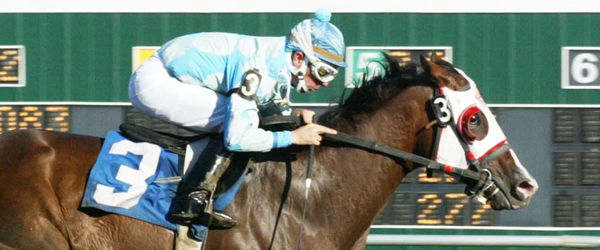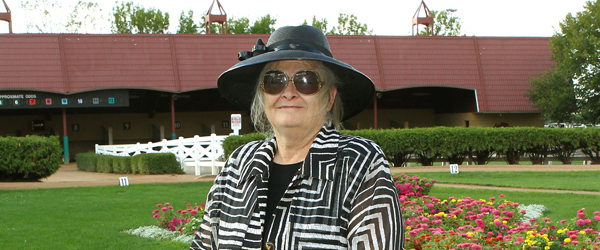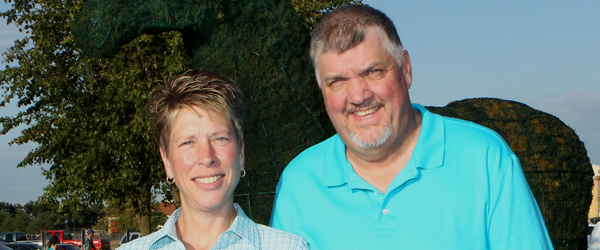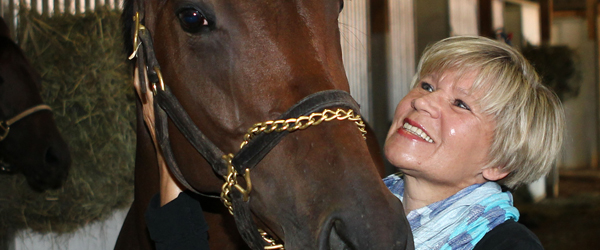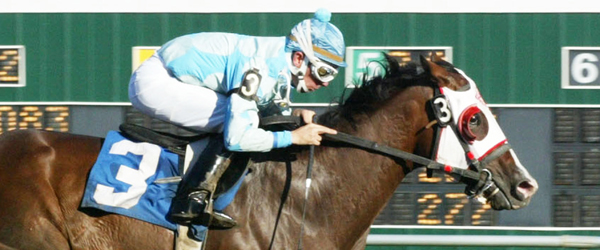On September 1, Canterbury Park held an induction ceremony for the Canterbury Park Hall of Fame: Class of 2012. The inductees were breeder Camelia Casby of Shakopee, MN; owners Robert and Julie Petersen of Cokato, MN; outstanding contributor Sheila Williams of Roseville, MN; and the multiple stakes winning mare Glitter Star. These inductees join a group of more than forty individuals and horses that comprise the best of Minnesota racing.
The Canterbury Hall of Fame was founded in 1995 to recognize people and horses that have made important and lasting contributions to the racing industry within the state. The selection committee consists of representatives of local horsemen organizations, local media and Canterbury Park.
[youtube http://www.youtube.com/watch?v=NJTWGE2boVo?rel=0]
Cam Casby: Hall of Fame Breeder
The morning consisted of phone calls, one after another. A race out east needed a decision before noon. Rain was forecast. Decided to scratch. Then there was the November Keeneland sale. Horses for market had to be entered by the next day. Oh, and her consignor for the Saratoga sale was leaving to look at horses. They had to talk. The current European exchange rate needed discussion, too.
Playing knee deep in the world of thoroughbreds is a full time job.
Then there was the local call this particular morning, someone inquiring about her induction into the Canterbury Park Hall of Fame. Her immediate reaction: “I’ve been told by people that I talk too much about my horses,” Cam Casby said.
Yes, and about what else is someone expected to talk who is involved with thoroughbreds and quarter horses twenty four hours a day, seven days a week?
“I’m not bragging. I just love all of my horses,” she added. “You have to have a passion in this business.”
Let no one ever accuse Ms. Casby of not having that passion.
Not many are capable of matching it, in fact. When she isn’t visiting her horses at Canterbury, she is on the phone with trainers elsewhere in the country discussing her other horses. Or she is reading the Daily Racing Form, or the latest thoroughbred magazine.
Several years ago she lived in Oakdale but would spend three and one-half hours a day or more on the road, driving to Canterbury and back for the morning workouts and returning again for the races that afternoon or evening.
So, she did the sensible thing and bought a home in Shakopee about 15 years ago. “It’s a townhouse, no lawn mowing, no snow shoveling,” Casby said.
Five minutes from the track and that, of course, means more time for horses and racing. “I am a little busier than normal right now because of the sales and the timetables involved,” Casby added.
Lest we get the wrong impression, Cam thought it important to note that on some mornings she doesn’t get a single phone call even though on other days she has gone through the batteries on as many as three different cell phones by 1 p.m.
“I have four or five of them,” she added, “and because I live in Minnesota and don’t travel as much as I used to, I spend more time on the phones now.”
It is all part of a life whose seed was planted while attending that fabulous Kentucky Derby in 1973, Secretariat’s race and year, a life that went unnurtured for many years thereafter because of law school, a law practice and the attendant duties of that profession.
Now she pursues her love of thoroughbreds with the same passion she once devoted to the law before retiring in 1990 and taking a long desired trip to Australia, New Zealand and Hawaii. The trip did, of course, include taking in the Melbourne Cup.
Casby began buying horses shortly thereafter. Her first, La Muttering, won only once in 22 or 23 starts but became her foundation mare. “She was very classy,” Cam added. “She’s the grandmother of Keewatin Ice and the great grandmother of Polar Plunge. She also produced Laurentide Ice.” The list of Cam’s runners goes on and on.
Casby is reluctant to pick out a favorite horse. “There is something special about each one,” she said. There are many she has owned solely or in partnership with her mother, Sylvia, and others.
One of her favorite stories, however, is how the name ‘light’ became a favorite for her quarter horses. Her father, Joe, wanted trainer Jerry Livingston to find a horse for them one time. Livingston said he would begin looking the next day. Joe asked “why not tonight?” Livingston responded, “It’s dark at night.” Joe then asked, “don’t you have a flashlight?”
Hence, the quarter horses carried names like CS Flashlight, CS Dee Light, CS Arc Light, CS Night Light, CS Limelight.
Casby is a former member of the HBPA board. “A very good one,” according to president Tom Metzen. “She took a lot of interest in the horsemen and horsewomen, was very interested in seeing that they were treated well. She was very philanthropic, too. She’s been a very good supporter of the industry and Canterbury Park,” added Metzen.
There is another clue to Casby’s intense interest in the equine world and its industry. When she practiced law, her specialty was criminal defense. “I didn’t like people so much after that,” she said.
She had found a new love, thoroughbreds and the industry that surrounds them, and now she is included in a group very much like herself in the Canterbury Park Hall of Fame.
Bob & Julie Petersen: Hall of Fame Owners
Maybe it was nothing more than a harbinger of things to come, a foretoken of their future success in an uncertain business, but the name of Bob and Julie Petersen’s first racehorse was misspelled on the registration papers.
Inclined to Cash somehow became ‘Inclinded to Cash’ and perhaps the quarter horse gods, shaking their heads in disbelief, compensated the Petersens by making them Canterbury Park’s all-time money earning leaders.
Just a thought. Just a hunch. How do you explain many things about racehorses, right?
Explaining the Petersens is much easier. All it takes is dedication seven days a week, passion and devotion twenty-four-seven, some smart business moves and determination in a sport that at its very best still delivers plenty of disappointment.
Come to think of it, there is nothing to this racehorse breeding and racing business that an iron will won’t get you through. The Petersens surely must have that kind of resolve, because people might stretch the truth, but the numbers never do.
And those numbers are revealing. The Petersens started the 2012 meet as Canterbury Park’s all-time leading quarter horse owners in earnings ($579,160) and wins (64). Their Callies Corona is the leading quarter horse earner at Canterbury with $97,258. She had seven wins, six seconds and three thirds from 20 starts, nine fewer starts than the second place horse on the list. Her seven wins at Canterbury (shared with seven others) are one fewer than the first place horse, Sparkle and Dance.
You get the impression that if the Petersens trained and rode their own horses they might lead in those categories, too.
Julie Petersen was raised with horses in Anoka. It didn’t take her long after the couple’s marriage to convert her husband. “No it didn’t,” Bob recalled. I enjoyed them right off the bat.”
Enough so that they have basically raised all of their own stock since sticking their toes in the water and leasing the first two horses they raced at Canterbury.
“We leased a horse on a Thursday and he won on Saturday,” Julie recalled. “He won his first and second outs and that set the hook.”
The Petersen story line is easy to follow as Julie relates it. “We got married in 1986, got our first racehorse in 1989 and have been at it ever since.”
Have they ever.
They bought their farm in 1987 and everything they’ve done in the quarter horse and thoroughbred business has been conducted from there.
“We raise our own horses. It’s hands on seven days a week,” Bob continued. “We raise them and we haul them ourselves, to every place we’ve raced. It’s really a family operation.”
That’s a lot of haulin’ over the years.
In addition to Canterbury Park, the Petersens have raced in Texas, Indiana, Chicago, New Mexico, California, Oklahoma and Louisiana. “Oh, and we can’t forget Fargo,” Bob said. “We went up there for a race one time and had a real good time. It was more like a fair atmosphere. People were having a riot of a time.”
They treated those long trips by truck as family outings, family getaways, as a way to see the country.
“It was fun,” Bob recalled. “We’d take the kids and get to see the countryside. We got to see a lot of places because of the horses.”
Bob and Julie have had to back off a bit now that the kids are out of the house and on their own.
“We’ve never had any hired help, no hands, just ourselves,” Bob said.
They raised five babies last year but cut back to four this season. In years past Morgan and Grant could help out. “If we had to do something, they could help with the chores,” Julie said.
The Petersens have had a number of stakes champions at Canterbury Park and throughout the entire United States.
There is Callies Corona, who set records for 330 yards at Prairie Meadows and at Canterbury Park. There was Seis It Fast, the track’s Horse of the Year in 2010. There was also Stone Cold Roller, Canterbury Quarter Horse of the year in 2007.
The Petersens have had a number of thoroughbreds over the years as well. Take Fizzling Ed, for one, the winner of the 1996 Minnesota Derby. They also lead all quarter horse owners on Festival Day with seven wins.
The roots of this successful operation can be found at For Amusement Only, whose residents there since the late 1980s are members of the Canterbury Park Hall of Fame hereafter.
There are ambassadors for the sport of horse racing, emissaries who carry the message of its history, grandeur and pageantry, the pomp and circumstance of a centuries-old sporting tradition. Then there is Sheila Williams.
No one in Canterbury Park history outdid this woman when it came to detailing the who, what, why or when of anything that happened on the grounds. Then again, she was a newspaperwoman before and after the racing bug bit and infected her for life during a trip to Santa Anita in the early 1980s
No one in Canterbury annals was ever more outwardly passionate about horse racing than Williams. No one cared any deeper, often at her own expense, about issues that affected racing.
Even today, years removed from Canterbury, long since retired as the track’s media manager, Williams will become a loquacious, articulate saleswoman for racing at the drop of a hat.
“Anyone who can’t look at a thoroughbred, even a $3,500 claimer, and see beauty and grace, must be blind,” Williams said recently.
Sheila Williams was part of the Canterbury Community before the press box was integrated and transformed into a place where a woman felt comfortable, welcome and on equal terms. “I was there before there was a ladies’ room,” she said, “and the toilet seats in both bathrooms were always up.”
It began for her during the early 1980s when her husband at the time was stationed in Southern California, serving on the USS Ranger. Navy life is often boring for a spouse without recreational interests of some kind.
Williams found hers during a trip to Santa Anita one day. “I thought to myself ‘how long has this been going on,'” she recalled. “I won all the races I bet on and I was hooked.”
Nothing changed during her first trip to Canterbury… while it was under construction nonetheless.
“I remember the first time I saw Canterbury,” she recalled. “A friend of mine and I drove out there, and there was nothing but cornfields and buildings going up. There was still only a dirt road (into the facility) and I thought it was most beautiful thing I had ever seen.”
That’s evidence enough to confirm this woman’s attraction to horse racing, but she demonstrated much more in the years that followed, as a newspaper reporter writing about this new Minnesota sport, as the track’s media front person, selling story ideas to the media, as a horse owner herself.
But first she sold tip sheets at Canterbury and then became a handicapper for the St. Paul Pioneer Press, a job she acquired with the encouragement of Dark Star after doing a story on him for the Skyway News.
Williams was there during the early years as a participant in the sport, a player at first, but always skirting the edge of the enterprise itself for some sort of job opportunity.
She owned or was partners in seven racehorses over the years. Her trainers were Peter David Knoll and Joey Ruhsam. Her favorite horse, by far, was Burn’s Term.
“I used the inheritance I got from my mother after she died to buy that horse,” she said. “I took a job at the Shakopee Valley News because it was so close and I could feed carrots to the horse during my lunch break.”
One of her beloved horse’s stablemates was Canterbury Park Hall of Fame horse Princess Elaine.
Williams sold tip sheets during the short stewardship of the Ladbroke Corp. and considers herself fortunate that she later worked for Randy Sampson and was part of a business approach that considered the fans first and foremost.
“What you see today at Canterbury because of it is not the dirty old men spitting on the sidewalk that infect some tracks, but families with their children enjoying a wonderful day together,” she said.
Williams also had a role in the acquisition of Canterbury Park’s race caller nonpareil Paul Allen, recommending him after acquiring a tape of his work at Bay Meadows, the result of a tip from Canterbury’s former Equibase chart caller Dave Miller.
She had a hand too in convincing people to get involved in racing and former owners to give it another go. “She had a lot to do with getting me back into the racing,” said owner Barry Butzow.
Williams took a look at the Hall of Fame photos on the second floor of the grandstand recently, reviewing each one.
“This racetrack would not be here, would not be the same without all of those people,” she said.
Now, she, too, is one of them. Always has been.
Fate, blind luck, happenstance, or simply being in the right place at the right time have influenced the histories of the world, often presenting opportunities that have uplifted, enhanced or changed entire lives and sometimes kingdoms.
Even on an extremely small, mundane scale, those factors often emerge, as they well do in the life of a horse named Glitter Star.
Had Bonnie Baskin not agreed to take that trip to the Keeneland Yearling sale with her father, had she not purchased the mare in foal to Glitterman, had she…
Had jockey Dean Butler and his wife, LeAnn, the horse’s groom and others not been in the stall with Glitter Star the night July 3rd fireworks worked her into frenzy, the night before the Princess Elaine Stakes…
Had Merrill Scherer not called his son, Gary, at Canterbury to inform him of a rider named Dean Butler headed to Canterbury from Kentucky in the first place…
The world is full of ifs, ands and maybes that frequently alter the course of events.
Such is the story of Glitter Star, a Canterbury Park star, a three-time winner of the Minnesota Distaff Classic, twice a champion of her division.
Baskin’s father wanted a partner to buy some yearlings in 2001, so Bonnie agreed and accompanied him to Keeneland where they bought four horses.
“While we were there I decided that I might as well buy a horse I could foal in Minnesota,” she said.
The mare was Saratoga Success. The foal was Glitter Star.
Welcome to the Land of 10,000 Lakes, gals.
Glitter Star had an 8-5-4 record from 29 career starts, an even more impressive dossier at Canterbury Park where she was 7-4-3 in 16 lifetime starts.
She bankrolled nearly a quarter million dollars during a career that began on June 24, 2004 and ended on Dec. 29, 2007. Butler rode her six consecutive times at Canterbury, including as a Princess Elaine winner the morning after the fireworks episode, and to one of her three Distaff wins. She also won the Minnesota Oaks and the Shakopee Stakes, under other riders.
“She was a sweetheart,” Butler recalled. “I just fell into her. I had just left Kentucky and Merrill called Gary and told him about me. It was an honor to ride her.”
The fireworks were lighting up the sky, the sound shaking her stall and Glitter Star was a mess the night before the Princess Elaine in 2006.
“Dean and LeAnn, the groom and everyone were all in there trying to calm her down the whole night,” recalled Gary. They soothed her heated mind and calmed her jangled nerves, and the next afternoon she outran Ma Home Cat by one-half length.
All three Scherers, Richie, Gary and Merrill, had a hand in the filly’s conditioning at one time or another. “I didn’t train her. I was Richie’s assistant,” Gary said. Nonetheless, he handled her care and workouts for extensive periods in Shakopee.
“She was just a runner. She performed every time,” he added.
“She always gave a good, hard honest effort,” said Richie Scherer. “She was a flashy, good looking filly who always tried.”
The one race in which Glitter Star was overmatched was the 2006 Lady Canterbury, 11 days after the Princess Elaine. She finished seventh to Radiant Avie, a ship-in trained by none other than Richie Scherer.
“My dad trained her [Glitter Star] awhile, I had her and my brother finished it out,” Richie said. “We all had something to do with her at one time or another. If there was one thing about her it was her consistency.”
Baskin shipped her to Kentucky for breeding the instant she was done racing. Glitter Star has delivered foals from Broken Bow, Songandaprayer, Sky Mesa, and Northern Afleet. She is currently in foal to Scat Daddy.
So, she has a second career under way in fine stead, much like her career on the track. “She was incredibly versatile,” Baskin recalled. “She could go wire to wire or win off the pace. She could run on grass or on dirt. In some ways, she was a push-button filly.”
A corneal abrasion and infection as a two-year-old nearly cost Glitter Star an eye. Around the clock administration of a variety of drugs at the Dahlberg farm saved the orb.
“We were lucky,” Baskin added. “We have a two-eyed horse for the Hall of Fame instead of a one-eyed horse.”
Blind luck doesn’t sound appropriate. Must have been fate.
This blog was written by Canterbury Staff Writer Jim Wells. Wells was a longtime sportswriter at the Pioneer Press and is a member of the Canterbury Park Hall of Fame.
Photo Credit: Coady Photography
